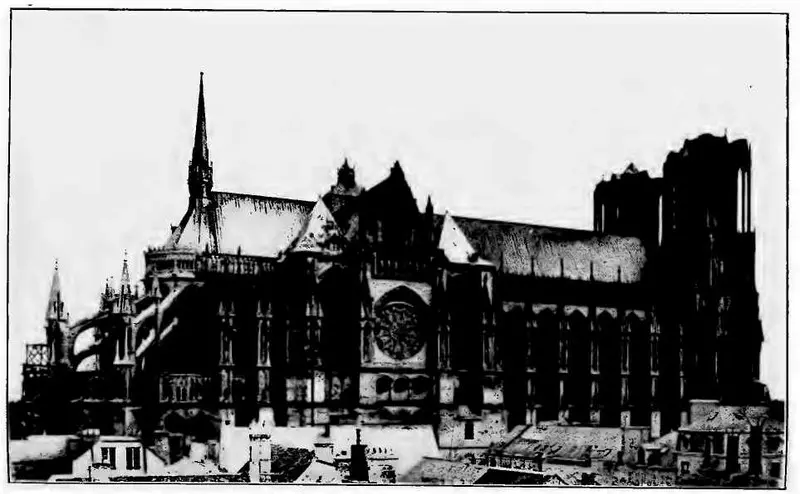James Walsh - The Thirteenth, Greatest of Centuries
Здесь есть возможность читать онлайн «James Walsh - The Thirteenth, Greatest of Centuries» — ознакомительный отрывок электронной книги совершенно бесплатно, а после прочтения отрывка купить полную версию. В некоторых случаях можно слушать аудио, скачать через торрент в формате fb2 и присутствует краткое содержание. Жанр: foreign_prose, История, foreign_edu, foreign_antique, на английском языке. Описание произведения, (предисловие) а так же отзывы посетителей доступны на портале библиотеки ЛибКат.
- Название:The Thirteenth, Greatest of Centuries
- Автор:
- Жанр:
- Год:неизвестен
- ISBN:нет данных
- Рейтинг книги:3 / 5. Голосов: 1
-
Избранное:Добавить в избранное
- Отзывы:
-
Ваша оценка:
- 60
- 1
- 2
- 3
- 4
- 5
The Thirteenth, Greatest of Centuries: краткое содержание, описание и аннотация
Предлагаем к чтению аннотацию, описание, краткое содержание или предисловие (зависит от того, что написал сам автор книги «The Thirteenth, Greatest of Centuries»). Если вы не нашли необходимую информацию о книге — напишите в комментариях, мы постараемся отыскать её.
The Thirteenth, Greatest of Centuries — читать онлайн ознакомительный отрывок
Ниже представлен текст книги, разбитый по страницам. Система сохранения места последней прочитанной страницы, позволяет с удобством читать онлайн бесплатно книгу «The Thirteenth, Greatest of Centuries», без необходимости каждый раз заново искать на чём Вы остановились. Поставьте закладку, и сможете в любой момент перейти на страницу, на которой закончили чтение.
Интервал:
Закладка:

CATHEDRAL (RHEIMS)
Reinach says: "There are certain prejudices against this admirable, though incomplete, art which it is difficult to combat. It is often said, for instance, that all Gothic figures are stiff and emaciated. To convince ourselves of the contrary we need only study the marvelous sculpture of the meeting between Abraham and Melchisedech, in Rheims Cathedral; or again in the same Cathedral, the Visitation, the seated Prophet, and the standing Angel, or the exquisite Magdalen of Bordeaux Cathedral. What can we see in these that is stiff, sickly, and puny? The art that has most affinity with perfect Gothic is neither Romanesque nor Byzantine, but the Greek art of from 500 to 450 B. C. By a strange coincidence, the Gothic artists even reproduce the somewhat stereotyped smile of their forerunners." Usually it is said that the Renaissance brought the supreme qualities of Greek plastic art back to life, but here is a thoroughly competent critic who finds them exhibited long before the Fifteenth Century, as a manifestation of what the self-sufficient generations of the Renaissance would have called Gothic, meaning thereby, barbarous art.
What has been said of sculpture, however, can be repeated with even more force perhaps with regard to every detail of construction and decoration. Builders and architects did make mistakes at times, but, even their mistakes always reveal an artist's soul struggling for expression through inadequate media. Many things had to be done experimentally, most things were being done for the first time. Everything had an originality of its own that made its execution something more than merely a secure accomplishment after previous careful tests. In spite of this state of affairs, which might be expected sadly to interfere with artistic execution, the Cathedrals, in the main, are full of admirable details not only worthy of imitation, but that our designers are actually imitating or at least finding eminently suggestive at the present time.
To begin with a well known example of decorative effect which is found in the earliest of the English Cathedrals, that of Lincoln. The nave and choir of this was finished just at the beginning of the Thirteenth Century. The choir is so beautiful in its conception, so wonderful in its construction, so charming in its finish, so satisfactory in all its detail, though there is very little of what would be called striving after effect in it, that it is still called the Angel Choir.
The name was originally given it because it was considered to be so beautiful even during the Thirteenth Century, that visitors could scarcely believe that it was constructed by human hands and so the legend became current that it was the work of angels. If the critics of the Thirteenth Century, who had the opportunity to see work of nearly the same kind being constructed in many parts of England, judged thus highly of it, it is not surprising that modern visitors should be unstinted in their praise. It is interesting to note as representative of the feeling of a cultured modern scientific mind that Dr. Osler said not long ago, in one of his medical addresses, that probably nothing more beautiful had ever come from the hands of man than this Angel Choir at Lincoln. As to who were the designers, who conceived it, or the workmen who executed it, we have no records. It is not unlikely that the famous Hugh of Lincoln, the great Bishop to whom the Cathedral owes its foundation and much of its splendor, was responsible to no little extent for this beautiful feature of his Cathedral church. The workmen who made it were artist-artisans in the best sense of the word and it is not surprising that other beautiful architectural features should have flourished in a country where such workmen could be found.
Almost as impressive as the Angel Choir was the stained glass work at Lincoln. The rose windows are among the most beautiful ever made and one of them is indeed considered a gem of its kind. The beautiful colors and wonderful effectiveness of the stained glass of these old time Cathedrals cannot be appreciated unless the windows themselves are actually seen. At Lincoln there is a very impressive contrast that one can scarcely help calling to attention and that has been very frequently the subject of comment by visitors. During the Parliamentary time, unfortunately, the stained glass at Lincoln fell under the ban of the Puritans. The lower windows were almost completely destroyed by the soldiers of Cromwell's army. Only the rose windows owing to their height were preserved from the destroyer. There was an old sexton at the Cathedral, however, for whom the stained glass had become as the apple of his eye. As boy and man he had lived in its beautiful colors as they broke the light of the rising and the setting sun and they were too precious to be neglected even when lying upon the pavement of the Cathedral in fragments. He gathered the shattered pieces into bags and hid them away in a dark corner of the crypt, saving them at least from the desecration of being trampled to dust.
Long afterwards, indeed almost in our own time, they were found here and were seen to be so beautiful that regardless of the fact that they could not be fitted together in anything like their former places, they were pieced into windows and made to serve their original purpose once more. It so happened that new stained glass windows for the Cathedral of Lincoln were ordered during the Nineteenth Century. These were made at an unfortunate time in stained glass making and are as nearly absolutely unattractive, to say nothing worse, as it is possible to make stained glass. The contrast with the antique windows, fragmentary as they are, made up of the broken pieces of Thirteenth Century glass is most striking. The old time colors are so rich that when the sun shines directly on them they look like jewels. No one pays the slightest attention, unless perhaps the doubtful compliment of a smile be given, to the modern windows which were, however, very costly and the best that could be obtained at that time.
More of the stained glass of the Thirteenth Century is preserved at York where, because of the friendship of General Ireton, the town and the Cathedral were spared the worst ravages of the Parliamentarians. As a consequence York still possesses some of the best of its old time windows. It is probable that there is nothing more beautiful or wonderful in its effectiveness than the glass in the Five Sisters window at York. This is only an ordinary lancet window of five compartments—hence the name—in the west front of the Cathedral. There are no figures on the window, it is only a mass of beautiful greyish green tints which marvelously subdues the western setting sun at the vesper hour and produces the most beautiful effects in the interior of the Cathedral. Here if anywhere one can realize the meaning of the expression dim religious light. In recent years, however, it has become the custom for so many people to rave over the Five Sisters that we are spared the necessity of more than mentioning it. Its tints far from being injured by time have probably been enriched. There can be no doubt at all, however, of the artistic tastes and esthetic genius of the man who designed it. The other windows of the Cathedral were not unworthy of this triumph of art. How truly the Cathedral was a Technical School can be appreciated from the fact that it was able to inspire such workmen to produce these wondrous effects.
Experts in stained glass work have often called attention to the fact that the windows constructed in the Thirteenth Century were not only of greater artistic value but were also more solidly put together. Many of the windows made in the century still maintain their places, in spite of the passage of time, though later windows are sometimes dropping to pieces. It might be thought that this was due to the fact that later stained glass workers were more delicate in the construction of their windows in order not to injure the effect of the stained glass. To some extent this is true, but the stained glass workers of the Thirteenth Century preserve the effectiveness of their artistic pictures in glass, though making the frame work very substantial. This is only another example of their ability to combine the useful with the beautiful so characteristic of the century, stamping practically every phase of its accomplishment and making their work more admirable because its usefulness does not suffer on account of any strained efforts after supposed beauties.
Читать дальшеИнтервал:
Закладка:
Похожие книги на «The Thirteenth, Greatest of Centuries»
Представляем Вашему вниманию похожие книги на «The Thirteenth, Greatest of Centuries» списком для выбора. Мы отобрали схожую по названию и смыслу литературу в надежде предоставить читателям больше вариантов отыскать новые, интересные, ещё непрочитанные произведения.
Обсуждение, отзывы о книге «The Thirteenth, Greatest of Centuries» и просто собственные мнения читателей. Оставьте ваши комментарии, напишите, что Вы думаете о произведении, его смысле или главных героях. Укажите что конкретно понравилось, а что нет, и почему Вы так считаете.












